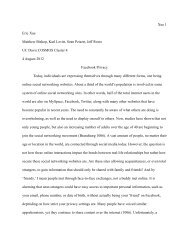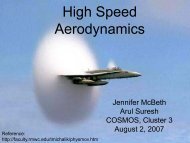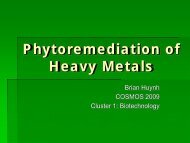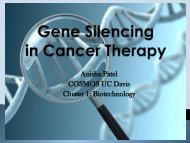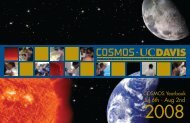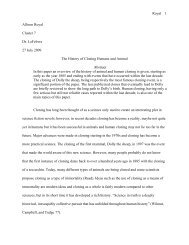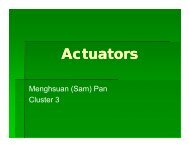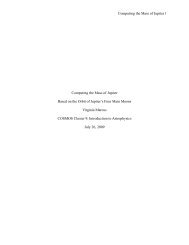hon, thomas - COSMOS - UC Davis
hon, thomas - COSMOS - UC Davis
hon, thomas - COSMOS - UC Davis
You also want an ePaper? Increase the reach of your titles
YUMPU automatically turns print PDFs into web optimized ePapers that Google loves.
Thomas Hon<br />
<strong>COSMOS</strong> <strong>UC</strong> <strong>Davis</strong><br />
Cluster 8: The Chemistry of Life<br />
August 5, 2011<br />
Hon 1<br />
Astemizole:<br />
Reducing<br />
its Potency and Serious<br />
Cardiac Side Effects
Hon 2<br />
Abstract<br />
Two new drugs were designed based off the framework of the original to improve<br />
its functionality in the human body. The original drug is an antihistamine called<br />
astemizole that relieves allergies. The main concern with astemizole is that it can<br />
potentially induce serious cardiac effects to the body that may lead to death. The drug<br />
was altered two different ways to provide probable solutions to lower its potency and<br />
prevent cardiac problems from occurring. Astemizole and its two analogs were drawn out<br />
on ChemDraw Ultra and Chem3D Pro to show their unique spatial and structural<br />
arrangements. Lipinski’s rules were used to see how well the analogs could be absorbed<br />
by or permeate through the body. Both analogs only met three out of the four rules. The<br />
analogs did not meet the requirement of having partition coefficients no greater than 5.<br />
Nevertheless, the analogs are appropriate because they both have a lower partition<br />
coefficient than astemizole, which also had a partition coefficient above 5. Computersimulated<br />
programs will be needed to confirm the binding abilities of the analogs to<br />
receptors before the analogs can be synthesized and tested on living organisms.<br />
Introduction<br />
Astemizole is a second-generation antihistamine that relieves seasonal or yearround<br />
allergies. The label “second-generation” is attributed to astemizole because it does<br />
not cross into the central nervous system (CNS) like most first-generation antihistamines<br />
do. Instead, astemizole only binds to the peripheral nervous system (PNS), targeting
Hon 3<br />
many of the body’s organs, including the stomach, intestines and uterus (“Astemizole<br />
Hismanal”). The absence of astemizole from CNS leads to fewer adverse side effects<br />
(Simons and Simons). Second-generation antihistamines also selectively bind better than<br />
those from the first-generation. First-generation antihistamines often activate many<br />
receptors in the body that produced unfavorable effects, such as epistaxis, anorexia, and<br />
dysuria. Second-generation antihistamines cure this problem by latching onto fewer<br />
receptors. Ultimately, most antihistamines target the histamine H1 receptor, the protein<br />
receptor that is responsible for allergies (“Antihistamines, H1 Receptor”).<br />
Astemizole functions by binding to the H1 receptor in place of histamine through<br />
competitive inhibition (Simons and Simons). As a result, histamine is blocked from<br />
binding to its own receptor. This process results in the inability of bodily cells to accept<br />
histamines. Since histamine is the firebrand of allergies, fewer allergies occur when<br />
antihistamines bind to receptors in the body. Therefore, less irritation occurs in the<br />
respiratory tract of the human body and allergies are alleviated (“Antihistamines, H1<br />
Receptor”).<br />
Janssen Pharmaceutica discovered astemizole in 1977. Branded under the name<br />
Hismanal, it was first introduced to North American markets in the mid-1980s<br />
(“Astemizole Hismanal”). Early studies showed that astemizole was similar in efficacy to<br />
other similar antihistamines at that time, but also had the added benefit of not causing<br />
drowsiness in patients (Richards). Troubling signs with the use of this product, though,<br />
arose as time wore on. The main concern with this drug was that it triggered Torsades de
Hon 4<br />
Pointes (TdP) in multiple patients, a potentially fatal form of ventricular tachycardia.<br />
(Simons et al.). Ventricular tachycardia is a type of heartbeat irregularity called<br />
ventricular arrhythmia that occurs when the ventricles of the heart start beating faster<br />
than usual but at a normal pace. However, as time passes, the heart changes in the QT<br />
interval, or the time it would take for the ventricles to contract (ventricular<br />
depolarization) and recover (ventricular repolarization). This prolongation of the QT<br />
interval leads to an extended period of ventricular repolarization, meaning that the flow<br />
and timing of ions that cross the myocardial (the heart's muscular tissue) cell membranes<br />
are disrupted. (“Ventricular Tachycardia”). During repolarization, these myocardial cells<br />
are usually resistant to electrical current, but when the ventricular repolarization is<br />
extended, these myocardial cells are more susceptible to electrical current. When<br />
myocardial cells are hit by an electrical current during repolarization and premature<br />
ventricular depolarization occurs, TdP is triggered (Dulak). Since there are varying<br />
degrees of TdP, it may be fatal or non-fatal and can sometimes be treated effectively with<br />
medication.<br />
Written reports of TdP activated by astemizole in the human body started<br />
appearing in medical journals a few years after the drug was introduced on the market. In<br />
1988, a 15 year-old girl in England had two episodes of TdP after collapsing outdoors.<br />
She had taken one tablet of astemizole 10 mg daily, the recommended dose, for ten<br />
weeks. She and her family had no history of cardiac problems or sudden death. After<br />
being admitted to intensive care, she continued to have a prolonged QT interval until TdP<br />
struck her five hours later. She was treated with appropriate anti-arrhythmic drugs
Hon 5<br />
immediately after TdP hit her and did not exhibit a reoccurrence of TdP after treatment.<br />
Her QT interval returned to normal in six days (Simons et al.).<br />
Another incidence, though non-TdP, appeared five years later. A 19 year-old<br />
woman suffered cardiac arrest while swimming. She had taken 20 mg of astemizole,<br />
twice the recommended dose, for several weeks because of hay fever. Her QT interval<br />
was prolonged, and stayed prolonged even after two months with a slightly high QT<br />
interval of 0.463 seconds. Although she had no family history of sudden death, her father<br />
and sister had long QT syndrome. Therefore, the 19-year old was postulated to have<br />
suffered from congenital long QT syndrome. However, astemizole likely aggravated her<br />
QT interval to dangerous levels near the point of possible TdP. Luckily, TdP did not<br />
strike her (Broadhurst). Both cases showed that astemizole was a primary factor in<br />
inducing extreme cardiac problems.<br />
Multiple cases of TdP and/or prolonged QT interval after ingestion of astemizole<br />
prompted government agencies to issue warnings about the intake of the drug. The<br />
Committee on Safety of Medicines, a British regulatory agency, issued a warning about<br />
astemizole in 1992 because of its potential to cause ventricular arrhythmias, or<br />
irregularities in heartbeat (Simons et al.). In February 1998, the US Food and Drug<br />
Administration (FDA) issued a warning stating that Hismanal (astemizole) could pose a<br />
fatal risk to patients with irregular heart rhythms. The FDA also ordered some changes to<br />
Hismanal's label to reflect concerns about the antihistamine's reaction with other drugs.<br />
The FDA's warning and the accumulation of adverse reports and warnings on astemizole<br />
may in part have led Janssen Pharmaceutica to voluntarily withdraw it from the market
Hon 6<br />
permanently in 1999 (“US Janssen”). Hismanal has not been remarketed since in the<br />
United States.<br />
Astemizole has the chemical formula C 28 H 31 FN 4 O and is created synthetically.<br />
This drug is readily absorbed from the gastrointestinal tract, metabolized by<br />
hemoproteins in the liver called Cytochrome P450, and excreted in the feces<br />
(“Hismanal”). Its Chemical Abstracts Service name is 1-[(4-Fluorophenyl)methyl]-N-[1-<br />
[2-(4-methoxyphenyl)ethyl]-4 piperidinyl]-1H-benzimidazol-2-amine. It exists in the<br />
solid form of a white crystalline powder. It is insoluble in water and soluble in most<br />
organic solvents such as chloroform or methanol. The molar mass of astemizole is<br />
458.57 g.<br />
F<br />
N<br />
H<br />
N<br />
N<br />
O CH 3<br />
N<br />
Fig. 1. Structure of Astemizole in 2D<br />
Hypotheses<br />
The replacement of the element fluorine with chlorine or the methyl group with<br />
carboxylic acid on astemizole will decrease the potency of the drug and prevent<br />
ventricular arrhythmias, specifically QT interval prolongation or TdP, from occurring in<br />
patients.
Hon 7<br />
Methods<br />
The ends of astemizole looked the most promising for improvement. Background<br />
information on elements and their binding properties was collected, and the hypotheses<br />
listed above were put into drawings via computer software. ChemDraw Ultra 10.0 was<br />
used to develop two-dimensional representations of astemizole and its analogs. Chem3D<br />
Pro 10.0 was used to create the previously mentioned figures in three dimensions. On<br />
Chem3D Pro, the structure was drawn first. Then, MM2 was run to optimize the structure<br />
and minimize its energy. The “calculate properties” feature was executed by using<br />
ChemPro inside Chem3D Pro software. This allowed the Log P values of the analogs to<br />
be calculated. Finally, CCDC Conquest 1.13 provided a standardized three-dimensional<br />
version of astemizole from the Cambridge Structural Database (CSD). Comparisons of<br />
the CSD structure to the one created in Chem3D Pro were done to find differences in<br />
conformations, bond length, and bond angles between the different models of astemizole.<br />
The first analog of astemizole consisted of a chlorine instead of a fluorine (Fig. 2).<br />
Although the addition of fluorine onto the original drug allowed for an effective drug in<br />
relieving allergies, the potent property of fluorine probably contributed to the drug’s<br />
possible fatal side effect of TdP. One study on an inhibitor found that the inhibitor<br />
without the fluorine was six times less potent than the one with fluorine (Bohm et al.)<br />
Another study showed that the introduction of fluorine substituents increased the potency<br />
of drugs ten-fold on average compared to the same drugs without fluorine (Purser et al.)<br />
Fluorine also forms a strong binding affinity with its target protein, the H1 receptor, but<br />
the attachment may be too strong. The binding of most H1 antagonists is readily
Hon 8<br />
reversible. However, astemizole does not readily dissociate from H1 receptors (Simons<br />
and Simons). The glue-like binding of astemizole with its receptor is usually a favorable<br />
condition because a tighter adhesion means that the drug can exert a greater amount of<br />
potency. Astemizole, with its ability to stick firmly onto the H1 receptor protein, can<br />
effectively block histamine from binding to the H1 receptor. Therefore, the consumer can<br />
be administered a lower dosage of astemizole for allergy relief. However, too much<br />
potency may contribute to adverse side effects. As with the case of astemizole, QT<br />
interval prolongation may lead to TdP, a deadly case of cardiac arrest.<br />
Cl<br />
N<br />
H<br />
N<br />
N<br />
O CH 3<br />
N<br />
Fig. 2. First Analog: Structure of Astemizole with Chlorine instead of Fluorine in 2D<br />
Chlorine is a viable alternative to fluorine because it has a lower electronegativity<br />
than fluorine, meaning that it will not bind as strongly to the H1 receptor protein. A<br />
slightly looser bond between astemizole and receptor will lower the potency of<br />
astemizole. Chlorine also has a lower bond dissociation energy (BDE), a measure of bond<br />
strength, than fluorine with carbon. Carbon bonded to fluorine has a BDE of 536 kJ/mol<br />
while carbon bonded to chlorine has a BDE of 397 kJ/mol. A lower BDE corresponds to<br />
a weaker bond. Comparing the two BDEs, the carbon-chlorine (C-Cl) bond will
Hon 9<br />
dissociate quicker. The faster dissociation of the C-Cl bond will allow Cl to react quicker<br />
in the body to fight off histamines and lower astemizole’s toxicity by getting out of the<br />
body faster. Although chlorine may exhibit stronger inhibitory activity than that of<br />
fluorine in antihistamines, this hypothesis is countered by two currently marketed<br />
antihistamine drugs in the United States that contain chlorine (Netter and Bodenschatz).<br />
Cetirizine (Zyrtec) and Azelastine (Astelin) both have chlorines attached to benzenes<br />
attached to carbon chains similar to that of the first analog. However, neither Zyrtec<br />
(“Cetirizine”) nor Astelin (“Azelastine”) show side effects of QT interval prolongation or<br />
TdP. The chlorine in both of these drugs do not justify the above findings and shows that<br />
it poses little to no harm to the cardiovascular system. Replacing the fluorine with a<br />
chlorine will also not change the molecular structure much; the other parts of the<br />
molecule will likely have the same interactions with the H1 receptor as before. All these<br />
aspects of the analog will reduce it from causing TdP or QT interval prolongation.<br />
An aspect that is not often considered is the net economic benefit of chlorine<br />
chemistry, or drugs that contain chlorine. Consumers save about $450 billion per year by<br />
buying drugs produced by chlorine chemistry, with the estimate based on the increased<br />
cost of maintaining health without the benefit of chlorine-containing drugs (“Chlorine<br />
Chemistry”). The replacement of fluorine with chlorine in astemizole can potentially<br />
erase its deadly side effects as well as allow astemizole to be more affordable for<br />
consumers.
Hon 10<br />
Fig. 3. First Analog: Structure of Astemizole with Chlorine instead of Fluorine in 3D<br />
The second analog of astemizole contained a carboxylic acid instead of the methyl<br />
group (Fig. 4). A new area of research is developing where nanoparticles are used in drug<br />
delivery systems. These nanoparticles help the drug target specific areas it is intended for.<br />
Precise targeting can lead to less toxicity within the bodily system. In a recent study,<br />
magnetic nanoparticles containing modified carboxyl groups were successfully produced<br />
and hypothesized to be practical for use in drug delivery systems (Hiroki et al.). Since<br />
carboxyl groups are potentially effective components for drug delivery, and drug delivery<br />
is used to lower drug toxicity, carboxyl groups like carboxylic acids can potentially<br />
reduce astemizole’s toxicity within the human body.
Hon 11<br />
F<br />
N<br />
H<br />
N<br />
N<br />
O<br />
COOH<br />
N<br />
Fig. 4. Second analog: Structure of Astemizole with Carboxylic Group instead of Methyl<br />
Group in 2D<br />
Astemizole not only binds to H1 receptors, but also inadvertently binds to H3<br />
receptors. H3 receptors that are stimulated significantly reduce the incidence and duration<br />
of ventricular fibrillation, a possible fatal result of TdP or QT interval prolongation (Levi<br />
and Smith). However, astemizole increases the risk of lethal cardiac side effects (“Second<br />
Generation”). Astemizole may need improved binding conditions surrounding the H3<br />
receptor to stimulate it. The carboxylic acid in my second analog allows it to act as a<br />
buffer when deprotonation occurs (Fig. 5), regulating the pH of the binding site of the<br />
protein. The buffer may control the drug from inflicting its large potency on the H3<br />
receptor. The controlled pH environment will allow a greater chance for the H3 receptor<br />
to be stimulated and astemizole to properly bind. Deprotonation of carboxylic acid will<br />
also allow charges to be balanced in the body and H+ ions to counteract or lower the<br />
potency of the highly electronegative fluorine molecule on the second analog. The<br />
regulatory effects of this analog will likely hamper its ability to induce cardiac<br />
irregularities.
Hon 12<br />
Fig. 5. Deprotonation of Carboxylic Acid<br />
Fig. 6. Second analog: Structure of Astemizole with Carboxylic Group instead of Methyl<br />
Group in 3D<br />
Results<br />
The modified versions of astemizole may be viable drug candidates. For a drug to<br />
likely function effectively in the body, Lipinski’s Rules of Five are used as a guide. They<br />
measure how well the body can absorb the drug or allow it to permeate. The rules state<br />
that in each drug, the number of hydrogen bond donors cannot exceed 5, the number of<br />
hydrogen bond acceptors cannot exceed 10, the octanol to water partition coefficient log<br />
P cannot exceed 5, and the molecular weight cannot exceed 500 g/mol. After evaluating<br />
astemizole and two other analogs, all three drugs have much fewer than five H bond
Hon 13<br />
donors and fewer than ten H bond acceptors (Table 1). The three drugs have molecular<br />
weights over 450 g/mol, but they all fit within the 500 g/mol limit set by Lipinski. One<br />
area of astemizole that contradicts Lipinski’s Rules is its partition coefficient. Astemizole<br />
has a Log P of 5.74, which is over the Log P of 5 set by Lipinski. The other two analogs<br />
also have a Log P over 5 (Table 2). However, the Log Ps of these analogs are lower than<br />
astemizole’s. All these factors evaluated about the analogs of astemizole signify that they<br />
are likely to work well in the body. Since experiments have not been performed on these<br />
analogs, they will have to be thoroughly tested to see if they are effective in performing<br />
the same function as astemizole but with less serious side effects.<br />
# of H Bond<br />
Modification<br />
Donors<br />
# of H Bond Acceptors<br />
Astemizole 1 5<br />
Astemizole with Cl instead of F 1 5<br />
Astemizole with COOH instead of<br />
CH3 2 7<br />
Table 1. Number of hydrogen bond donors and acceptors listed for astemizole and two<br />
novel analogs.<br />
Modification Log P Molecular Weight<br />
Astemizole 5.74 (from internet) 458.57 g/mol<br />
5.648<br />
Astemizole with Cl instead of F (from Chem3D Pro) 475.08 g/mol<br />
Astemizole with COOH instead of<br />
CH3<br />
5.283<br />
(from Chem3D Pro) 488.61 g/mol<br />
Table 2. Partition coefficients Log P and molecular weights shown for astemizole and<br />
two novel analogs.
Hon 14<br />
The structure of astemizole from the Cambridge Structural Database (CSD) in<br />
CCDC Conquest (Fig. 7) was also compared to the 3D figure of astemizole created using<br />
Chem3D Pro (Fig. 8). Astemizole created with Chem3D looks much more planar than<br />
and not as angular as the one from CSD. The bond lengths in CSD are shorter than the<br />
ones in Chem3D, and bond angles in CSD appear to be wider than those on Chem3D.<br />
The minimizing energy program in Chem3D allowed astemizole’s conformations to be<br />
positioned in the most desirable away. However, this may cause astemizole to act<br />
differently in the body. More thorough research will have to be done to see which models<br />
of astemizole (ex. from Chem3D and CSD) bind better to the histamine H1 receptor.<br />
Fig. 7. Structure of Astemizole from Cambridge Structural Database (CSD) in CCDC<br />
Conquest 1.13
Hon 15<br />
Fig. 8. Structure of Astemizole in 3D<br />
Discussion<br />
The two analogs created provide alternatives to the potentially deadly drug of<br />
astemizole. Many benefits may be associated with the alterations made to the analogs, but<br />
setbacks may arise during experimentation. The new element or group substituted in for<br />
the original may react or bind differently in the body, or exhibit other adverse side effects<br />
that are more powerful than those of astemizole. Advanced computer simulation software<br />
can be used to see how well the analogs bind to the H1 receptor or other histamine (H2-<br />
H4) receptors. If the analogs bind well enough, the drugs will have to be synthesized and<br />
tested through the three main phases of clinical trials. Repeated testing of the analogs<br />
inside living organisms will be necessary to make sure that the analogs are effective in<br />
blocking histamine and safe to use. The tests will provide helpful feedback on the<br />
absorption, distribution, metabolism, excretion, and toxicity of the analogs.<br />
Antihistamines have a large influence on many people's daily lives. Pharmacies as<br />
well as many websites are making them available to consumers in large quantities. The<br />
estimated worth early in 2011 of the world antihistamine market was about 4.2 billion<br />
euros, or 5.45 billion in U.S. dollars (“Orexo”). The significant market value of this
Hon 16<br />
product around the world illustrated the mass amount of people purchasing these drugs to<br />
alleviate their allergy symptoms. In the first decade of the 21 st century, the FDA approved<br />
of many histamines to be sold over-the-counter, such as Claritin (“FDA Sends”) or Zyrtec<br />
(“FDA Approves”). The switch from prescription to over-the-counter has made<br />
antihistamines more accessible to the American public and allowed these medications to<br />
drop in prices to attract consumers to purchase them. Currently marketed antihistamines<br />
in the U.S. approved by the FDA are generally safer to take than those marketed in the<br />
past. However, older ones like astemizole were stepping stones to the development and<br />
creation of improved ones that exhibit fewer side effects and greater effectiveness.<br />
Recent developments on the molecular level have allowed scientists to discover<br />
more detailed information receptor proteins in the body. In late June 2011, scientists<br />
solved the three dimensional crystal structure of the human Histamine H1 receptor<br />
protein by growing crystals. The discovery will provide scientists a better understanding<br />
of how the receptor works and interacts with its environment (“Human Histamine”).<br />
More research and development into antihistamines, specifically how they adapt and bind<br />
to receptors, will provide a deeper understanding into how their side effects can be<br />
minimized.
Hon 17<br />
Acknowledgments<br />
I would like to thank Professors Allen, Guo, and Mascal for giving lectures that<br />
advanced my scientific knowledge and answering my questions, teacher assistants<br />
Asuman, Slava, and Zane for answering my questions and helping me in labs and on how<br />
to use chemistry computer software, Professor Tantillo for explaining the considerations<br />
that go into making drugs, teacher fellow David for giving me feedback on my research<br />
project, and my parents for their constant encouragement and support.
Hon 18<br />
Literature Cited<br />
"Antihistamines, H1 Receptor Antagonist Class Review." Pharmacy.oregonstate.edu.<br />
College of Pharmacy- Oregon State University. Web. 23 July 2011.<br />
"Astemizole Hismanal Antihistamine." Antihistamine.com. Domain Millwork, 2011.<br />
Web. 23 July 2011.<br />
"Azelastine Nasal Spray." Ncbi.nlm.nih.gov. PubMed Health, 1 Sept. 2008. Web. 24 July<br />
2011.<br />
Broadhurst, Paul, and Ant<strong>hon</strong>y W. Nathan. "Cardiac Arrest in a Young Woman with the<br />
Long QT Syndrome and Concomitant Astemizole Ingestion." HeartJ 70 (1993):<br />
469-70. PubMed.gov. Web. 25 July 2011.<br />
.<br />
"Cetirizine." Ncbi.nlm.nih.gov. PubMed Health, 1 Oct. 2010. Web. 24 July 2011.<br />
"Chlorine Chemistry: Providing Pharmaceuticals That Are Essential2health."<br />
Americanchemistry.com. American Chemistry Council, 2011. Web. 27 July 2011.<br />
Deprotonation of carboxylic acid. Digital image. Jiplp.oxfordjournals.org. Oxford<br />
Journals, 1 Sept. 2006. Web. 30 July 2011.<br />
Dulak, Sallie B. "Torsades De Pointes." RN Magazine. Modern Medicine. Web. 25 July<br />
2011.
Hon 19<br />
"FDA Approves Zyrtec for Nonprescription Use in Adults and Children." U S Food and<br />
Drug Administration. 28 May 2009. Web. 27 July 2011.<br />
.<br />
"FDA Sends Claritin over the Counter." CNN.com. Cable News Network, 27 Nov. 2002.<br />
Web. 27 July 2011.<br />
Hiroki, Tomoyuki, et al. "Functional Magnetic Nanoparticles for Use in a Drug Delivery<br />
System." Journal of Physics. Iopscience.iop.org. 08 Apr. 2011. Web. 28 July<br />
2011. .<br />
"Hismanal." RxList.com. 8 Dec. 2004. Web. 23 July 2011.<br />
"Human Histamine H1 Receptor Protein Crystal Structure Solved- Breakthrough in<br />
Allergy Drug Discovery" Sciencedebate.com. 25 June 2011. Web. 28 July 2011.<br />
Joachim-Bohm, Hans, et al. "Fluorine in Medicinal Chemistry." ChemBioChem 5.5<br />
(2004). Wiliey Online Library. 28 Apr. 2004. Web. 26 June 2011.<br />
.<br />
Levi, Roberto, and Neil C.E. Smith. "Histamine H3-Receptors: A New Frontier in<br />
Myocardial Ischemia." THE JOURNAL OF PHARMACOLOGY AND<br />
EXPERIMENTAL THERAPEUTICS 292.3 (1999): 825-30.<br />
Jpet.aspetjournals.org. JPET. Web. 27 July 2011.<br />
.
Hon 20<br />
Lu, Yunxiang, Yong Wang, and Weiliang Zhu. "Nonbonding Interactions of Organic<br />
Halogens in Biological Systems: Implications for Drug Discovery and<br />
Biomolecular Design." Pubs.rsc.org. RSC Publishing, 25 Mar. 2010. Web. 27<br />
July 2011. .<br />
Netter, K.J., and K. Bodenschatz. "Inhibition of Histamine-N-methylation by Some<br />
Antihistamines." Biochemical Pharmacology 16.8 (1967): 1627-631.<br />
Sciencedirect.com. 16 Nov. 2002. Web. 27 July 2011.<br />
.<br />
"Orexo Licenses Abstral to Invida for in Asia Pacific: GlaxoSmithKline Gets Rights to<br />
Bilastine in Spain and Poland." Thepharmaletter.com. 17 Jan. 2011. Web. 24 July<br />
2011. .<br />
Purser, Sophie, et al. "Fluorine in Medicinal Chemistry." The Royal Society of Chemistry<br />
37.2 (2008). Pubs.rsc.org. RSC Publishing, 13 Dec. 2007. Web. 26 July 2011.<br />
.<br />
Richards, DM, et al. "Astemizole. A Review of Its Pharmacodynamic Properties and<br />
Therapeutic Efficacy." PubMed.gov. Web. 24 July 2011.<br />
.<br />
"Second Generation Antihistamines." Antihistamine.com. Domain Millwork, 2011. Web.<br />
23 July 2011.
Hon 21<br />
Simons, F. Estelle R., and Keith J. Simons. "The Pharmacology and Use of H1-Receptor-<br />
Antagonist Drugs." The New England Journal of Medicine 330.23 (1994): 1663-<br />
670. NEJM.org. Web. 23 July 2011.<br />
.<br />
Simons, F.E.R., et al. "ASTEMIZOLE-IND<strong>UC</strong>ED TORSADE DE POINTES." The<br />
Lancet 332.8611 (1988): 624. ScienceDirect.com. Web. 24 July 2011.<br />
.<br />
"US Janssen Pulls Hismanal from Market." ICIS.com. 21 July 1999. Web. 23 July 2011.<br />
"Ventricular Tachycardia- Topic Overview." Webmd.com. WebMD. Web. 25 July 2011.




